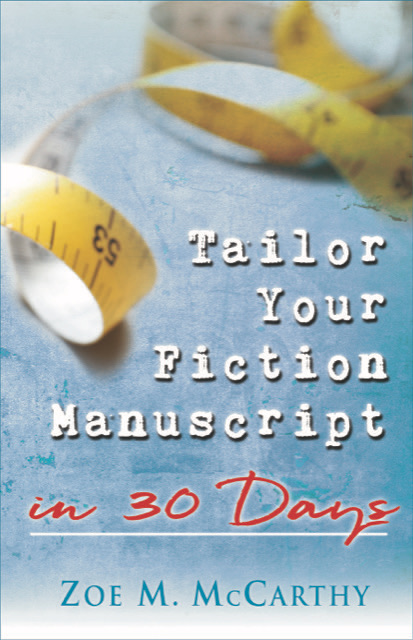

Tailor Your Fiction Manuscript in 30 Days now available. See details below.
We’ve all heard, “Hire an editor.” And I do. Here are four other things you can do to avoid errors in your book.
1. Check for typos in the changes you make during editing.
Sometimes deadlines make it easy for typos and other errors to creep into our stories. This happened to me. I had limited time to apply edits from my freelance editor before an indie novella was due for a collection. As I read the Kindle version, I was appalled to find eight typos. Eight! The errors have been corrected. Thank goodness.
Most of the eight typos occurred when I was quickly making a change my editor had suggested. Really? I’d hired an editor to catch my typos along with grammar and story issues, then included typos in making the changes?
You can be sure from now on, no matter how pressured I am, I will check twice for typos in the changes I make.

2. When receiving galleys ask at least one other person to read them for errors. The more the better.
My husband reads my galleys. We always find a typo the other doesn’t find, and sometimes we both miss one.
Tell your editor about the typo you find after you’ve sent back galleys. I’ve done so, and my publisher has made the correction.
For self-published books put on such publishing platforms as KDP, make corrections you or others find. You want readers to have an error free read.
If you’re a reader, letting authors know about typos you see, especially on a Kindle version, is usually appreciated.
3. Don’t miss a comma, period, quotation mark, or single-letter edit among other more complicated edits in track changes.
If I’m not careful, I get wrapped up in what my editor has marked as wordy or awkward and miss that comma, period, or quotation mark she inserted. Also, don’t zip by that vertical line on the left margin in track changes that has no bubble message on the right side. It’s usually flagging something the editor has inserted.

4. Scan the final manuscript for word processor flagged words to catch the valid ones you’ve missed.
But don’t blindly accept the ones you question. Look up the spelling and grammar issues of words. For example, my word processor always calls for a comma after an opening so.
“Your copper hair complements your green eyes,” Mark said.
“So you think I’m pretty.”
My word processor just flagged that so. But when sosignals a similarity or suggests logical continuity, no comma. This is usually the case.
I get so used to the red squiggles flagging the spelling of characters’ names, such as Jassie, that I fail to spot a valid warning. Now I add such names to the spelling and grammar dictionary so the processor doesn’t flag them. My possible errors stand out.
What tips do you have to help us produce an error-free book?

Zoe McCarthy’s book, Tailor Your Fiction Manuscript in 30 Days, is a fresh and innovative refocusing of your novel or novella. Through a few simple—and fun—steps, Zoe helps writers take their not-ready-for-publication and/or rejected manuscripts to a spit-polish finish. Writing is hard work, yes, but it doesn’t have to be difficult. —Eva Marie Everson, best-selling and multiple award-winning author, conference director, president of Word Weavers International, Inc.
If you want to increase your chance of hearing yes instead of sorry or not a fit for our list at this time, this book is for you. If you want to develop stronger story plots with characters that are hard to put down, this book is for you. Through McCarthy’s checklists and helpful exercises and corresponding examples, you will learn how to raise the tension, hone your voice, and polish your manuscript. I need this book for my clients and the many conferees I meet at writer’s conferences around the country. Thank you, Zoe. A huge, #thumbsup, for Tailor Your Fiction Manuscript in 30 Days. —Diana L. Flegal, literary agent, and freelance editor
Tailor Your Fiction Manuscript is a self-editing encyclopedia! Each chapter sets up the targeted technique, examples show what to look for in your manuscript, then proven actions are provided to take your writing to the next level. Whether you are a seasoned writer or a newbie, you need this book! —Sally Shupe, freelance editor, aspiring author


 RSS - Posts
RSS - Posts



Adding proper names to the spelling and grammar dictionary is a smart idea, but I don’t know how to do that. I guess I better get Googling! Thanks for the tip!
Hi Kelly, I have Microsoft office for a Mac. I think it’s best to Google to get the directions you need. Thanks for coming by.
Thank you for the great tips.
You’re welcome, Melissa.
For the rewrites, you can have your computer read your changes. I catch a lot of errors that way.
Thanks for adding that, Marcia. I do that when I edit as I finish writing a scene. Good idea to do it after finishing a section of making final edits.
I have students who have told me, with a straight face, “I don’t kneed to prove reed cause my writings prefect.” Oh, my!
Sheri, you made me chuckle. We all “Kneed to prove reed”!
Start with a great critique partner, tn there are less errors to weed through.
Excellent advice, Jane. Every bit of eyes you can get on a manuscript helps.